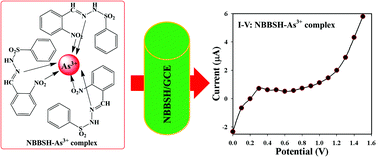(E)-N′-(2-Nitrobenzylidene)-benzenesulfonohydrazide (NBBSH) was prepared from 2-nitrobenzaldehyde and benzenesulfonylhydrazine by using a simple condensation process with medium yield. It was then crystallized in methanol and characterized using various spectroscopic techniques such as Fourier transform infra-red spectroscopy (FTIR), ultra-violet visible spectroscopy (UV-vis), proton nuclear magnetic resonance (1H-NMR), X-ray photoelectron spectroscopy (XPS), and carbon-13 nuclear magnetic resonance (13C-NMR). The structure of the NBBSH molecule was confirmed using the single crystal X-ray diffraction technique (SCXRDT). A thin layer of NBBSH slurry was deposited onto a cleaned and dried flat round surface of GCE with a binding agent (Nafion) to fabricate a sensitive and selective heavy metal ion (HMI) sensor. The fabricated NBBSH/GCE sensor exhibited enhanced sensing performances such as sensitivity, limit of detection (LOD), linear dynamic range (LDR), and long-term stability towards selective arsenic ions. The calibration curve (CC) was found to be linear over a broad range of As3+ conc. (0.1 nM–0.1 M) and the calculated sensitivity and LOD (based on 3N/S) were found to be ∼190.0 pA μM−1 cm−2 and 50.0 pM, respectively. This novel approach can be used as an efficient path for the development of HMI sensors regarding monitoring of hazardous materials in biological and environmental sciences.

